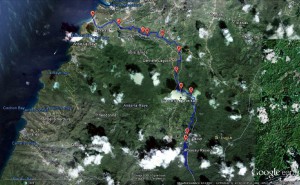John Compton Dam (aka Roseau Reservoir) in St. Lucia are affected by severe long term sedimentation, increased by recent sedimentation impacts of a hurricane induced flood. As the reservoir represents the major drinking water storage capacity for the northern part of the country, the effects on water supply are severe. If untreated, the sediment situation as well as drinking water provision in future will worsen, intensifying the countries water shortage. In addition the sediment body represents an additional load on the dam and thus a permanent risk. The concrete faced rockfill dam is not designed for taking this load, especially as some of its construction elements and foundation are already damaged by landslides and floods. Therefore short term action as well as a sustainable solution is urgently required on the sediment situation for security reasons. However, the conducted detailed survey revealed that the overall sediment situation is in some points different to what had been assumed before.
Additional repair on the dam, its constructional elements and its foundation are necessary, too. However, that is not part of this study which has been executed on short notice within a very tight time schedule. The dam site and access road offer limited admission for heavy traffic in its present condition. Assembling and working space near the dam crest is hardly available, especially on the water side of the dam. This, too, limits applicable/available equipment and installation. Usual access to the reservoir is limited to a makeshift slip ramp which is capable for occasional watering of small and light boats. Taking this into account, no heavy equipment can be installed next to or within the reservoir rapidly.
Several approaches for technical solutions have been analyzed within this study. However, due to missing space next to the reservoir for sediment storage the only applicable method for sediment removal from the reservoir is a downstream passage of the sediment by light equipment using ConSedTrans-Method. The process offers near-nature sediment transfer, restoring sedimentation/erosion equilibrium in a near nature state if applied over sufficient time periods. In addition to the technical benefits the method is the only one which also provides ecological benefits by restoration effects.

In any case dredging measures in the headwater close to the dam can only take place in the dry season for security reasons, when the spillway is not in operation. The conducted sediment gauging showed that this part of the overall dredging work can wait until end of the rain season but should begin immediately after. Depending on hydrology the overall recovery measure will take approximately 4 years, followed by a sustainable sediment management. Project cost will be in the range of 3.0 M€ / 3.9 M US$ (thereof 1.7 M€ / 2.2 M US$ investment and 1.3 M€ / 1.7 M US$ operation) for recovery project and 0.09 M€ / 0.12 M US$ per year for a sustainable sediment management, following the initial project.
The required water for sediment transfer could also be used for installation of a 250 kW hydropower plant which could be added to John Compton Dam. After full restoration of the reservoirs storage capacity the hydro plant would also provide additional economic benefit. To cope with any sediment load we recommend the installation of two Turgo-type hydropower units, each rated 125 kW and totaling 250 kW. The turbines can be connected to the existing bottom outlet, once the area around the bottom intake is cleared from sediment. Coated Turgo type turbines are mostly efficiency-resistant to sediment load in propulsion water and offer good efficiency over a wide range of water head. An alternative is the installation of two Francis units of the same size with coated turbine runners. The power station will allow renewable energy production as well as emergency power supply to the drinking water pumps at grid outage. Rehabilitation work on dam elements should already integrate preparations for a hydropower facility. The constructions cost of the power station is considered in the range of 0.75 M€ / 1.0 M US$.
Read also: